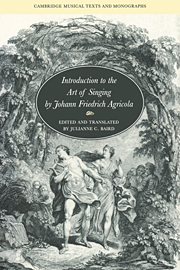Book contents
- Frontmatter
- Contents
- Acknowledgments
- Introduction: Agricola's treatise
- INTRODUCTION TO THE ART OF SINGING
- Translator's preface
- Foreword of the author
- Introduction of the author
- 1 Observations for the use of the singing teacher
- 2 Concerning appoggiaturas
- 3 Concerning trills
- 4 Concerning divisions
- 5 Concerning recitative
- 6 Remarks intended especially for the music student
- 7 Concerning arias
- 8 Concerning cadenzas
- 9 Remarks for the use of the professional singer
- 10 Concerning improvised variations of melodies
- Notes
- Bibliography
- Index
8 - Concerning cadenzas
Published online by Cambridge University Press: 10 December 2009
- Frontmatter
- Contents
- Acknowledgments
- Introduction: Agricola's treatise
- INTRODUCTION TO THE ART OF SINGING
- Translator's preface
- Foreword of the author
- Introduction of the author
- 1 Observations for the use of the singing teacher
- 2 Concerning appoggiaturas
- 3 Concerning trills
- 4 Concerning divisions
- 5 Concerning recitative
- 6 Remarks intended especially for the music student
- 7 Concerning arias
- 8 Concerning cadenzas
- 9 Remarks for the use of the professional singer
- 10 Concerning improvised variations of melodies
- Notes
- Bibliography
- Index
Summary
1. There are two types of final cadences in the aria. Composers call these the one from above and the one from below. To make this [distinction] more comprehensible to the student, I will say that in C major, the notes of the first type of cadence would be La Sol Fa (E D C); and those of the second, Fa Mi Fa (C B C) (a). In solo arias or in recitatives, the singer may choose the type he prefers. If, however, other singing voices or instruments are combined at the cadence, he may not interchange them, but must strictly adhere to the one that has been prescribed (b).
(a) The various types are already given in music examples on page 128. The most common cadence nowadays in arias is the following: C D C.
(b) Because the two voices, or the voice and the instrument, that were to perform the cadence and the trill together, either in thirds or in sixths, would then be in unison. What is said here about instruments is to be understood as [referring to] one instrument accompanying the voice. For if there are only violins accompanying [during] the final cadence, as seldom occurs, the singer is also free, especially in the final trill, to sing the trill from above or from below, since one of the instruments will always be playing one of the two [kinds of cadences] in unison with him.
- Type
- Chapter
- Information
- Introduction to the Art of Singing by Johann Friedrich Agricola , pp. 204 - 215Publisher: Cambridge University PressPrint publication year: 1995



